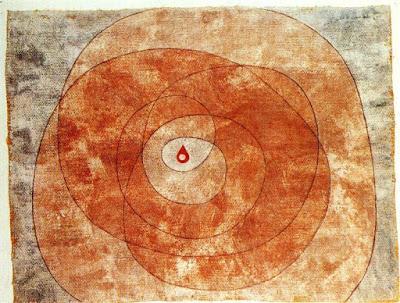
At the Core by Paul Klee
What shapes the mind and heart? What shapes our being?From our genes, parents, culture, and the food we consume we are constantly being shaped and re-shaped. Many things take shape from the inside out, like from the space between thoughts or actions, and even the space and time between breaths.
The shape of our body is continually being molded—influenced by our thoughts and feelings. Our posture is often a reflection of what’s going on internally in the mind and heart. The content of the mind/heart so to speak wears the body like a glove; the glove can be too tight, too loose, and will even eventually just drop away. The posture we take, or allow to take us over, in many instances is directed from the inside out.
When practicing asana then, we have this phenomenal opportunity to shape and be shaped. We can shape ourselves from the inside—by being mindful of our thoughts and feelings and recognizing the affects they have on our physical body. We can also utilize the actual shape of a pose to examine the internal landscapes that we might not have previously spent much time in. For instance, we might stay in a posture for a while and rest the mind in an area of the body that seems internally tight or uncomfortable, and allow our awareness like light to permeate it, seep into it.
Awareness is often compared to light. In this scenario, the light of awareness can illuminate a “dark,” shadowy, or even previously unknown area of the body. Many times there are sections or parts of the interior landscape of our bodies aren’t familiar. Henry David Thoreau said in Walden:
“Direct your eye sight inward and you will find a thousand regions in your mind. Yet undiscovered. Travel them and be expert in home cosmography.”
Say for instance, when exploring the belly as a region, one might not have much of a sense of the belly and possibly not breathe into the area much at all because it’s tight or where nervousness shows up or anxiety displays its affects. By taking a posture that opens that particular area, for instance, a restorative Bridge pose (Setu Bandha), we can then turn the light of our awareness into that area and feel any sensations in that place.
By staying aware of sensations in a particular area of the body, we eventually become familiar with it or, in some cases, feel things where we haven’t before. By becoming familiar with sensations somewhere, we know when there are unusual ones—signals of distress for instance, like tightening, or pain—and when we notice these red flags we have the opportunity to address them by relaxing purposefully or breathing into the area to soften it. Sometimes just the awareness is enough to release any tensions.
This mindfulness of the body can translate as a powerful way to take care of oneself because we are addressing a signal of distress before it becomes an outcry or chronic condition. We can become sensitive to the body and take care of the thoughts and feelings that take hold of the tissue, that change the internal landscape, and that have the potential to cause problems because they also have the potential to be calmed and worked with as they arise.
In this way intention, repetition, patience, and lots of kindness can create and sustain a beautifully shaped and openhearted life. Every single moment we are alive to have choice, we shape ourselves. And even when we cease to exist, the shape of our life lived leaves a space behind it for others to fill, pause in or improve upon, or simply to remember. As Marcel Proust said:
“The true voyage of discovery consists not in seeking new landscapes but in having new eyes.”
Subscribe to Yoga for Healthy Aging by Email ° Follow Yoga for Healthy Aging on Facebook ° Join this site with Google Friend Connect

